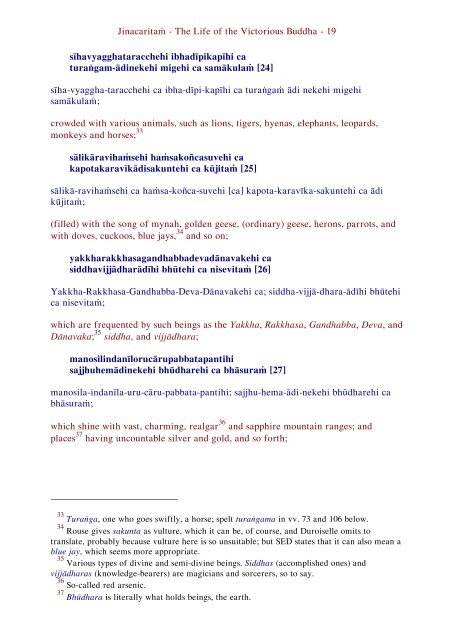Jinacaritaṁ: The Life of the Victorious Buddha
A Pāli and English line by line (interlinear) version of this Medieval verse biography of the Buddha from his Bodhisatta aspiration to the founding of the Jetavana monastery (together with extensive annotation).
A Pāli and English line by line (interlinear) version of this Medieval verse biography of the Buddha from his Bodhisatta aspiration to the founding of the Jetavana monastery (together with extensive annotation).
Create successful ePaper yourself
Turn your PDF publications into a flip-book with our unique Google optimized e-Paper software.
<strong>Jinacaritaṁ</strong> - <strong>The</strong> <strong>Life</strong> <strong>of</strong> <strong>the</strong> <strong>Victorious</strong> <strong>Buddha</strong> - 19<br />
sīhavyagghataracchehi ibhadīpikapīhi ca<br />
turaṅgam-ādinekehi migehi ca samākulaṁ [24]<br />
sīha-vyaggha-taracchehi ca ibha-dīpi-kapīhi ca turaṅgaṁ ādi nekehi migehi<br />
samākulaṁ;<br />
crowded with various animals, such as lions, tigers, hyenas, elephants, leopards,<br />
monkeys and horses; 33<br />
sālikāravihaṁsehi haṁsakoñcasuvehi ca<br />
kapotakaravīkādisakuntehi ca kūjitaṁ [25]<br />
sālikā-ravihaṁsehi ca haṁsa-koñca-suvehi [ca] kapota-karavīka-sakuntehi ca ādi<br />
kūjitaṁ;<br />
(filled) with <strong>the</strong> song <strong>of</strong> mynah, golden geese, (ordinary) geese, herons, parrots, and<br />
with doves, cuckoos, blue jays, 34 and so on;<br />
yakkharakkhasagandhabbadevadānavakehi ca<br />
siddhavijjādharādīhi bhūtehi ca nisevitaṁ [26]<br />
Yakkha-Rakkhasa-Gandhabba-Deva-Dānavakehi ca; siddha-vijjā-dhara-ādīhi bhūtehi<br />
ca nisevitaṁ;<br />
which are frequented by such beings as <strong>the</strong> Yakkha, Rakkhasa, Gandhabba, Deva, and<br />
Dānavaka; 35 siddha, and vijjādhara;<br />
manosilindanīlorucārupabbatapantihi<br />
sajjhuhemādinekehi bhūdharehi ca bhāsuraṁ [27]<br />
manosila-indanīla-uru-cāru-pabbata-pantihi; sajjhu-hema-ādi-nekehi bhūdharehi ca<br />
bhāsuraṁ;<br />
which shine with vast, charming, realgar 36 and sapphire mountain ranges; and<br />
places 37 having uncountable silver and gold, and so forth;<br />
33 Turaṅga, one who goes swiftly, a horse; spelt turaṅgama in vv. 73 and 106 below.<br />
34 Rouse gives sakunta as vulture, which it can be, <strong>of</strong> course, and Duroiselle omits to<br />
translate, probably because vulture here is so unsuitable; but SED states that it can also mean a<br />
blue jay, which seems more appropriate.<br />
35 Various types <strong>of</strong> divine and semi-divine beings. Siddhas (accomplished ones) and<br />
vijjādharas (knowledge-bearers) are magicians and sorcerers, so to say.<br />
36 So-called red arsenic.<br />
37 Bhūdhara is literally what holds beings, <strong>the</strong> earth.


















